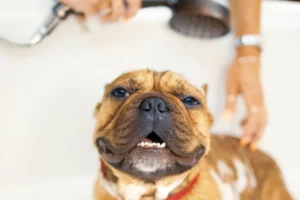After a refreshing bath, your cat may start to shiver uncontrollably. This behavior can be concerning for many cat owners, but there’s no need to worry – this reaction is actually quite common among felines. So why does your cat shiver after a bath? Let’s explore the reasons behind this fascinating behavior.
Sensitivity to Temperature Changes
Cats are known to be more sensitive to temperature changes compared to humans. Their bodies are naturally designed to maintain warmth, which is why they have a higher body temperature than we do. When a cat is bathed, the sudden exposure to water and cooler temperatures can cause them to shiver. This shivering is their body’s way of trying to generate heat and regulate their temperature. To help your cat feel more comfortable after a bath, make sure the room is warm and cozy, and consider using a towel or blow dryer on a low heat setting to help dry them off quickly.
Stress and Anxiety
The stress and anxiety of being bathed can also play a significant role in why your cat is shivering post-bath. Cats are known to be creatures of habit and prefer their grooming routine to be done on their terms. Bathing can be a stressful experience for many cats, as they may feel vulnerable and out of control. This stress can lead to shivering even after the bath is over. To help alleviate this anxiety, try to make the bathing process as calm and quick as possible. Use a gentle touch, speak softly, and offer treats or rewards afterwards to create positive associations with bath time. Additionally, consider using products specifically designed for cats that are gentle on their skin and fur, reducing any discomfort or irritation that may contribute to their stress.
Unique Insight: Providing a post-bath treat or favorite toy can help distract your cat from any lingering stress and anxiety, encouraging a more positive post-bath experience.
Remember, every cat is different, so it’s essential to observe your furry friend and tailor your approach to their individual needs. By understanding their sensitivity to temperature changes and addressing their stress and anxiety, you can help ensure a more comfortable and pleasant bath time for your feline companion.
Rapid Cooling of Wet Fur
When your cat gets a bath, its fur becomes wet, causing rapid cooling of the body. This sudden drop in temperature can lead to your furry friend shivering as a natural response to regulate its body heat. Just like how we shiver when we’re cold, cats use this mechanism to generate heat and warm up after being exposed to water.
Moreover, cats have a higher body temperature than humans, around 100 to 102.5 degrees Fahrenheit. So, when their fur gets wet, the cooling effect on their skin can be more pronounced, triggering shivering to counteract the loss of heat. It’s a way for them to maintain their ideal body temperature and prevent any potential discomfort from being too cold.
Unique Insight: Additionally, during grooming sessions, cats will lick their fur to distribute natural oils and regulate body temperature. When these oils are washed away during a bath, it can further contribute to the sensation of coldness and amplify the shivering response.
Instinctual Response to Water
Cats have an instinctual aversion to water due to their ancestors’ habitats in arid environments. In the wild, getting wet could mean a hindrance to hunting and discomfort in the harsh elements. Therefore, when subjected to a bath, cats may feel stressed, anxious, or even scared, which can manifest as shivering.
Aside from the discomfort of being wet, the scent of soap or shampoo used during the bath can also be unfamiliar and cause additional stress. Cats rely heavily on their sense of smell, so any new scents introduced during bath time can trigger a heightened state of alertness and anxiety, leading to shivering as a physical response to the emotional stress they are experiencing.
Remember, after a bath, provide a warm, cozy environment, and gently towel dry your cat to help them warm up and regain comfort.
For further insights into cat behavior and care, you can check out this helpful resource on cat grooming tips: Cat Care Society – Grooming Your Cat
Comfort and Soothing Techniques
After a bath, it’s common for cats to shiver as they try to regulate their body temperature. To help your feline friend feel more comfortable and relaxed, try wrapping them in a warm towel. Gently pat them dry instead of rubbing vigorously, as this can cause more stress. Talking to your cat in a calm and reassuring voice can also help soothe their nerves. If your cat enjoys being brushed, a gentle brushing session after the bath can provide a comforting sensation. Remember, patience and gentle handling go a long way in comforting your shivering kitty.
Importance of Drying
Properly drying your cat after a bath is crucial in preventing excessive shivering. Water trapped in their fur can lead to chills, making them shiver even more. Use a clean towel to gently absorb excess water from their coat. If your cat allows it, you can also use a hairdryer on a low setting, keeping a safe distance to avoid overheating. Pay special attention to drying their paws and belly, as these areas tend to retain more moisture. By ensuring your cat is completely dry post-bath, you can help minimize their shivering and keep them cozy and comfortable.
- Use a clean towel to gently pat your cat dry, avoiding excessive rubbing.
- If your cat tolerates it, use a hairdryer on a low, cool setting to speed up the drying process.
- Remember to focus on drying their paws and belly, where moisture tends to linger.
Remember, cats have different comfort levels, so be observant and adjust your techniques accordingly to help them feel at ease after their bath.
Seeking Veterinary Advice
If your cat continues to shiver excessively after a bath, it may be time to consult a veterinarian. While some shivering is normal, persistent shaking could indicate an underlying issue. A vet can help rule out any potential health concerns and provide guidance on how to make the bathing process more comfortable for your feline friend. Remember, your cat’s well-being is a top priority, so don’t hesitate to seek professional advice if needed.
By understanding the reasons behind your cat’s shivering after a bath, you can better address any potential issues and ensure they are happy and healthy. Remember, a little extra care and attention can go a long way in keeping your furry companion content.
Additional Tip: Provide a Warm Towel
After giving your cat a bath, try wrapping them in a warm towel to help them dry off and stay cozy. The warmth can help soothe their nerves and lessen the chances of excessive shivering. Just make sure the towel is not too hot to avoid discomfort for your cat. This simple gesture can make a significant difference in how your cat reacts to bath time.
Alex, a passionate animal lover, has experience in training and understanding animal behavior. As a proud pet parent to two dogs and three cats, he founded AnimalReport.net to share insights from animal experts and expand his knowledge of the animal kingdom.




